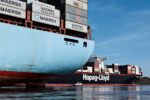Archives
Business, Feature, Freight News, Sea
Hub Port Performance Key for Gemini
[ April 5, 2024 // Gary G Burrows ]The Gemini cooperation agreement between Maersk and Hapag-Lloyd will rely heavily on a small number of transshipment hubs to support its new hub-and-spoke network, according to Drewry’s latest quarterly Ports and Terminals Insight report.
While several of the terminals within the planned network reflect world-class operational performance in terms of intensity of asset use, strong performances will be essential for Gemini’s strategy.
Since MSC and Maersk announced in January 2023 that the 2M alliance would end in early 2025, there’s been much speculation on how each partner will “go it alone” on the major trade lanes covered by the agreement.
As it turns out, Danish headquartered Maersk will not be setting out solo, instead announcing in January 2024 that it will instead enter into the new Gemini cooperation agreement with leading German carrier Hapag-Lloyd beginning in February 2025, immediately after the end of the 2M alliance.
The Gemini cooperation agreement covers seven trades – Asia/U.S. West Coast, Asia/U.S. East Coast, Asia/Middle East, Asia/Mediterranean, Asia/North Europe, Middle East-India/Europe and transatlantic – and comprises 26 mainline services supported by 32 dedicated shuttle routes.
The planned network streamlines the number of port calls in each region with the aim of reducing disruption. The loops focus heavily on hub-and-spoke transshipment hubs supported by high-capacity dedicated shuttle loops that link the regional hubs with other gateway ports. Combined, the mainline services will call at only 56 ports, with a further 29 ports served by dedicated shuttles.
Drewry’s recently published Ports and Terminals Insight report takes a deep dive into the planned network to look at the selected hub terminals and assess their readiness to support the shuttle feeder strategy.
Partners Hub Ports
The Gemini cooperation agreement will make extensive use of 15 hub ports (see map). APMT operates terminals in eight of the selected ports, with Hapag-Lloyd having operational terminals in two of the ports while investing in a third. The high level of ownership across the hub port network provides the partners with a greater degree of control over operational management and investment plans – both of which will be key to the success of the hub-and-spoke strategy the partnership will employ.
Several of the selected hub ports are already world leaders in terms of operational performance – APMT’s facilities in Tanger Med are both handling more than 2,000 TEUs per meter of quay and more than 200,000 TEU per crane, as is APMT Salalah. Tanjung Pelepas, Singapore, East Port Said and Algeciras – all of which handle high levels of transshipment – also rank highly in Drewry’s annual survey of terminal performance.
Capacity expansion projects across the network are also well advanced at the hub ports where utilization levels are high. The investments pipeline is spread across physical expansion of terminal assets (Rotterdam, East Port Said, Tangier MedPort), upgrade of capability to handle ultra-large container vessels (e.g. Bremerhaven, Salalah), and automation/digitalization initiatives (e.g. Wilhelmshaven, Shanghai).
While the use of high-capacity dedicated shuttle services will facilitate efficient use of yard space at the hub ports, any repeat of the supply chain disruption seen in 2021-22 will put the Gemini network strategy under extreme pressure, Drewry warns. The hub ports will need to provide sufficient buffer storage to make up for any mainline or feeder vessel delays.
The full briefing on the implication of the Gemini cooperation agreement on key transshipment ports is available for subscribers of Drewry’s Ports and Terminals Insight (https://www.drewry.co.uk/maritime-research-products/ports-and-terminals-insight-annual-subscription).
The quarterly report covers the latest developments in the container ports and terminals market and includes monthly updates providing regular port congestion and performance monitoring.
Monthly analysis of port performance and congestion across global and eight regional port markets, powered by Drewry AIS analytics, includes: monthly port throughput growth trend analysis; port call analytics and development trends; port performance monitoring, broken-down by pre-berth waiting time, terminal time, port congestion heatmaps by region; and pre-berth waiting time analysis comparisons across selected ports.
Drewry’s ports and terminals advisory services provides analysis to financial Institutions, port authorities, terminal operators, and governments covering commercial and technical aspects of ports and terminals.

Tags: Gemini, Hapag-Lloyd, Maersk











